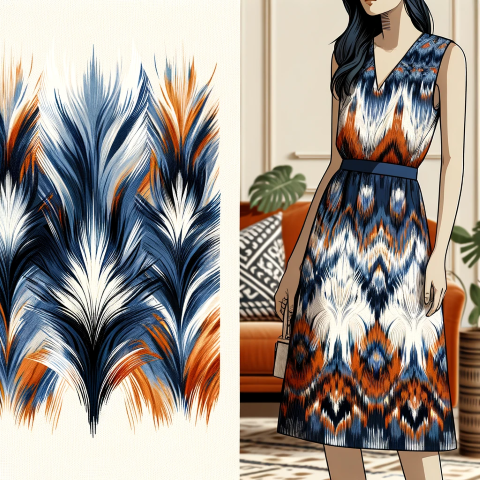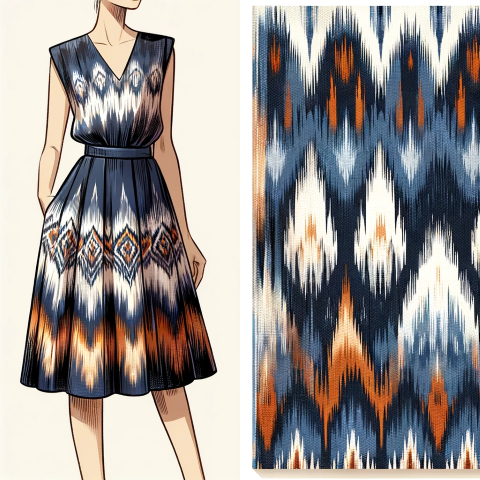Last Updated on: 19-Apr-2024 (3 months, 8 days ago)
Share on Facebook • Share on Twitter
Ikat Weaving Mastery: Discovering Textile Art Across Cultures
Ikat Patterns Unveiled: Tracing the Global Weaving Journey
Ikat is a textile art form recognized for its unique dyeing technique that involves resist dyeing the yarns before weaving the fabric. Originating from the Malay-Indonesian term "mengikat," meaning "to tie" or "to bind," ikat is distinguished by its process of binding and dyeing sections of yarn to create intricate patterns on textiles.
The intricate and captivating patterns of ikat textiles are a testament to a craft that has traversed through time and cultures. Employing resist dyeing on the yarns prior to weaving the fabric, its a process that demands precise methods to produce its characteristic blurred-line design.
Historical Significance of Ikat
Originating from Southeast Asia, the art of ikat weaving is laden with historical significance. The craft spread along the Silk Road, illustrating a cross-cultural exchange that dates back to the early centuries. Regions in Central Asia, the Indian subcontinent, Japan, and Latin America have all developed unique styles of ikat, each telling their own historical and cultural narratives.
- Yarn Preparation:Yarns of various natural fibers are prepared for the dyeing process.
- Binding:Selected areas of the yarn are tightly wrapped to resist dye penetration.
- Dyeing:The wrapped yarn is dyed, traditionally with natural dyes, and the bindings are later removed to reveal the pattern.
- Weaving:The dyed yarns are woven on a loom, carefully aligning the dyed patterns to form the design.
- Pattern Emergence:During weaving, the pattern emerges, requiring precision to ensure design alignment.
- Warp Ikat: Only the warp yarns are dyed with the ikat technique.
- Weft Ikat: Only the weft yarns are resist-dyed.
- Double Ikat: Both warp and weft yarns are dyed, representing the most intricate ikat type.
The beauty of ikat lies in the subtle variations of its designs, making each ikat piece unique. The technique is employed for various applications from traditional clothing to decorative art.
- In Asia, countries such as India, Japan (known as "kasuri"), and Indonesia are renowned for their ikat techniques.
- In Central and South America, ikat is integral to traditional attire.
- African ikat is characterized by distinctive cultural patterns and dyeing techniques.
Ikat textiles are appreciated globally for their cultural significance and artisanal quality, reflecting the heritage and craftsmanship of their makers.
Tips for Handling Ikat Textiles
- Always dry-clean to preserve the integrity of the dyes and fibers.
- Store in a dry, dark place to prevent fading and moisture damage.
- For home-washing, use cold water and gentle detergents, and avoid wringing the fabric.
Entities renowned for their ikat production
They have been pivotal in both preserving traditional methods and innovating within the industry:
- Pochampally Ikat: Pochampally, a region in Telangana, India, is famous for its ikat weaving, particularly silk ikats known as Pochampally Sarees. These textiles are characterized by their geometric patterns and have been granted Geographical Indication status in India, recognizing their unique cultural heritage. The weavers in Pochampally have formed cooperatives to market their work, such as the Pochampally Handloom Weavers Co-operative Society Ltd, ensuring that benefits go directly to the artisans.
- Guatemala Ikat: Guatemala is renowned for its vibrant cotton ikat textiles, often used in traditional clothing like the Mayan huipil. Guatemalan ikat, known locally as jaspe, is handwoven on backstrap looms, with artisans in regions such as Quetzaltenango leading the craft. Cooperatives like Trama Textiles work to empower women weavers, preserving traditional techniques and promoting fair trade.
- Japanese Ikat (Kasuri): In Japan, ikat is known as kasuri, a technique mastered in areas like Okinawa and Kurume. The Kurume Kasuri Kimono is a sought-after garment that showcases the intricacy of Japanese ikat weaving. Organizations like the Kurume Kasuri Weaving Cooperative provide support to weavers, ensuring the art form's continuity and authenticity.
- Uzbek Ikat: Uzbekistans ikat fabrics, known as abrbandi, are celebrated for their bold, elaborate designs and silk construction. Cities like Margilan are hubs of ikat production, where entire families are involved in the complex process of dyeing and weaving. The craft is supported by initiatives like the Margilan Crafts Development Center, which promotes Uzbek ikats internationally while providing education and resources to local artisans.
- Indonesian Ikat: In Indonesia, ikat is part of the national heritage, with distinct styles emerging from islands such as Sumba, Flores, and Timor. Threads of Life, a fair trade business based in Bali, works with Indonesian weaving cooperatives to produce traditional ikats while also engaging in cultural preservation and environmental conservation.
These ikats are used in everything from ceremonial garments to modern fashion and home dcor.
- Fashion: Ikat is widely used in clothing, from runway dresses to everyday wear, reflecting both luxury and tradition.
- Home Dcor: Ikat patterns are a popular choice for home textiles, including upholstery, curtains, and cushions.
- Cultural Significance: Traditional ikat garments hold cultural significance in many regions, worn during ceremonies and rituals.
Ikat is more than a textile; it is a language of color and pattern that has been spoken for centuries. As we look towards the future of fashion and design, ikat stands resilient, an emblem of sustainable practices and cultural diversity. The adaptability of ikat in modern applications is a testament to its timeless appeal, promising to continue its legacy for generations to come.
�Ikat is a style of weaving that uses a tie-dye process on either the warp or weft before the threads are woven to create a pattern or design. A Double Ikat is when both the warp and the weft are tie-dyed before weaving.
�Term applied to the resist-dye process in which designs are reserved in warp or weft yarns by tying off small bundles of yarn with palm-leaf strips or similar material to prevent penetration of dye. From the Indonesian mengikat, 'to tie' or 'to bind'.
Some more terms:
Sheaths
Usually have straight or close fitting skirts, accompanied by a form fitting bodice. The skirt is often ankle length and sometimes has a slit in either the front, side, or back to make walking...
Read about SheathsAzo-free Colorants: A Vibrant Palette Without the Peril
Azo-free colorants are dyes and pigments that are free of the nitrogen-based compounds aromatic amines, also referred to as "Azos". These compounds are toxic and banned in the EU due to their...
Read about Azo-free colorantsEyelets: The Delicate Artistry Transforming Textile Design
Grommets and eyelets are metal, plastic, or rubber rings that are inserted into a hole made through another material. They may be used to reinforce the hole, to shield something from the sharp edges...
Read about EyeletCamp Pockets
Camp pockets are a unique feature found in certain textile products, particularly outdoor gear and camping equipment. These specialized pockets are designed to enhance functionality and convenience...
Read about Camp PocketsPocket Weave
Textile weaving techniques have evolved over centuries, giving rise to numerous intricate and unique fabric structures. One such fascinating weaving method is pocket weave, known for its distinctive...
Read about Pocket WeaveProtease
Enzymes that are involved in the breakdown of proteins. They are the most widely used enzymes in detergents; it removes protein stains from egg, grass, blood, and sweat. Also used to treat wool and...
Read about ProteaseDacca Muslin
Dacca Muslin, also known as Dhaka Muslin, is a legendary fabric with a rich history and exceptional craftsmanship. Renowned for its delicate texture, sheer fineness, and intricate weaving, Dacca...
Read about Dacca MuslinStenter
An open-width fabric-finishing machine in which the selvedges are so held by attachments to a pair of endless travelling chains that the fabric is finished to a specified width. NOTE: a) Attachments...
Read about StenterOn this page
Add a definition
- The term you want to define
- Its definition in 500 words or less
- Attach an image if necessary.
- Optionally, tell us about yourself in 200 words or less!
Companies for Ikat:
- Company name
- Company address
- Attach a logo, if necessary.
- Optionally, tell us about yourself in 200 words or less!

 The Turkish textile industry contributes significantly to the country's GDP.
The Turkish textile industry contributes significantly to the country's GDP.

